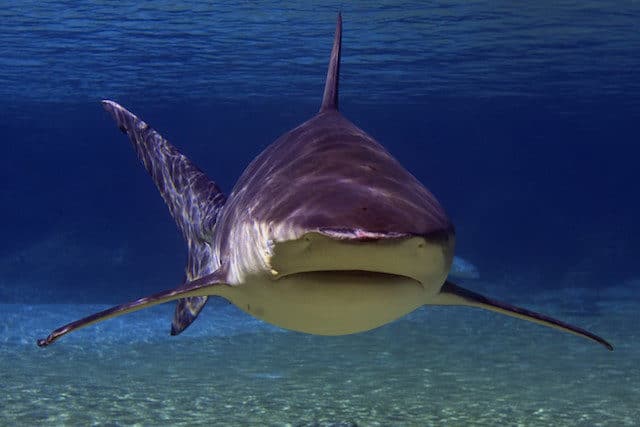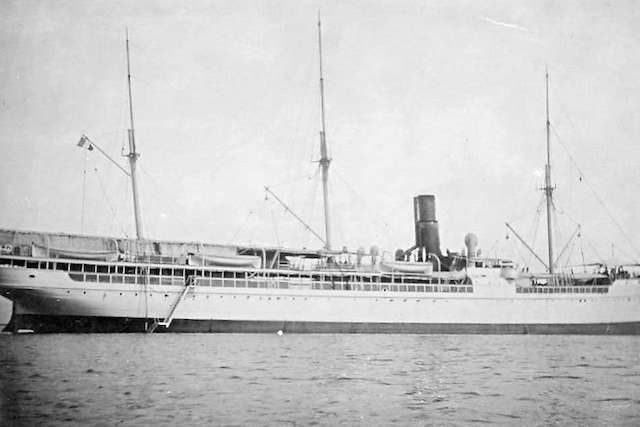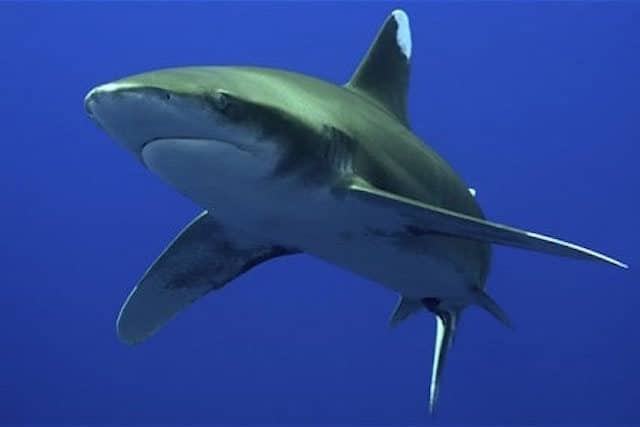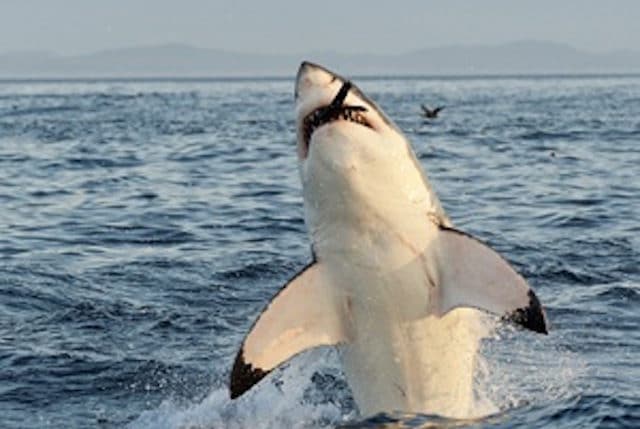Yes, sharks are horrifying killing machines. They’ve been on Earth for 450 million years, which is longer than trees have been around, and throughout their history many species have been (and still are) apex predators. However, the good news is that even though sharks can be dangerous to humans, most of the time they are not. The odds of being bitten by a shark are about 1 in 3.7 million. So you’re more likely to be hit by lightning, or to be bitten by Uruguayan soccer player Luis Suarez, than you are to be bitten by a shark.
However, just because they are rare, doesn’t mean they don’t happen. These are 10 of the most horrifying shark attacks.
10. Heather Boswell
In early 1994, 19-year-old Heather Boswell joined the National Oceanic and Atmospheric Administration (NOAA) to serve food to a crew on an expedition in the South Pacific Ocean. On March 23, 1994, Boswell was swimming 300 miles east of Easter Island with eight shipmates. Suddenly, someone yelled shark. Everyone swam as quickly as they could to the boat to get away from the 14-foot Great White shark, but not everyone made it to safety unscathed. The first person the shark attacked was Phil Buffington. He was bitten on the leg.
Next, the shark moved towards Boswell. As it got close, Boswell stopped moving because she was afraid of kicking the shark. When she stopped moving, the shark bit her right leg. Meanwhile, three crew members got on a raft to go help her. When they got to her, they tried to pass her a stick, and when she grabbed it, the shark bit her on the left leg and pulled her under the water. The shark shook her, but amazingly, it brought her back to the surface again, right near the raft. When she popped back up again, one crew member tried to hit the shark with a stick while two other crew members pulled Boswell onto the raft, and when she was pulled aboard, she heard a pop. When she looked down, her leg was gone at mid-thigh. The shark went after a third person who was climbing a rope ladder out of the water and onto the boat, but luckily they were not hurt.
Buffington and Boswell were airlifted to the hospital and both survived. Buffington received 50 stitches while Boswell had to get a prosthetic leg.
9. Jessie Arbogast

On July 6, 2002, 8-year-old Jessie Arbogast was playing with his sister and cousins in shallow water in Pensacola, Florida. Vance and Diana Flosenzier, Jessie’s aunt and uncle, were about to call the children in for dinner when one of them shouted “Shark!” Vance and Diana ran to the beach and saw a cloud of blood in the water. The shark had Jesse’s right arm in its mouth, and it was rolling. Finally, the arm came off and Diana – along with some bystanders – pulled Jessie from the water. Besides losing his arm, a big chunk of Jessie’s right thigh was also missing. As a result, he was nearly drained of blood, and he stopped breathing. Diana and other bystanders were forced to perform CPR on the boy for 10 minutes.
Meanwhile, Vance grabbed the shark, which was a 7-foot bull shark, by the tail and dragged it ashore. A park ranger shot the shark and the arm was pulled from the shark’s mouth. Jessie was taken to the hospital and slipped into a coma. His arm was reattached, his leg was mended, and he came out of the coma. Unfortunately, due to the coma, Jessie is confined to a wheelchair and can no longer speak.
8. La Seyne Disaster

At about 4:00 in the morning on November 14th, 1909, the French liner La Seyne collided with the British liner Onda, about 26 miles from Singapore. The collision split the La Seyne in half and it sank in two minutes. Since most people on board were in bed at the time of the crash and the boat sank so quickly, 101 people sank with the ship. 61 people managed to get off of the boat and the Onda lowered three life rafts in the water.
The survivors had a problem getting into the lifeboats because it was not only dark and foggy, which is why the boats crashed, but sharks were also attacking many of the survivors. When the people were pulled from the water, many of them had injuries from the sharks and in some cases they were severe. However, it does not appear that the sharks were responsible for any deaths.
7. Rodney Temple

On October 14, 1972, Rodney Temple, Bret Gilliam, and Robbie McIlvaine were divers on a scientific expedition off the coast of Saint Croix, which is an island in the U.S. Virgin Islands. On that day, they were taking pictures at a depth of 210 feet underwater. During their dive, Temple saw two whitetip sharks. Both of them were over 12 feet long.
On the way to the surface, the divers needed to stop along the way to decompress. The last man up should have been Temple. However, when a large air bubble rose through the water from under them, Gilliam and McIlvaine knew something was wrong. Gilliam swam down to help, while McIlvaine, who was running out of oxygen, went to the surface.
When Gilliam reached Temple, one of the sharks had bitten him on the thigh and then the second one bit him on the calf. Gilliam and Temple punched the sharks and they let go, but only briefly. The sharks latched back onto Temple and dragged him down. Gilliam held onto Temple and he was dragged down as well. Eventually it got to be about 400 feet below the surface and Gilliam had run out of oxygen. He had no other choice but to let Temple go and swim towards the surface. Miraculously, he made it without drowning. He did suffer decompression sickness, though, and spent two days in the hospital.
Unfortunately, Temple’s body has never been recovered.
6. Tamara McAllister and Roy Jeffrey Stoddard

On January 26, 1989, 24-year-olds Roy Jeffrey Stoddard and his girlfriend, Tamara McAllister set out from Malibu, California, on what should have been a short kayaking trip. However, when they didn’t return later that day, a search was launched.
The day after they went missing, their kayaks were found tied together. This is a common practice for kayakers who are resting. However, in one of the kayaks there were three large holes, which the authorities said was caused by a Great White shark.
The next day, McAllister’s body was found floating in the water. Parts of her legs and buttocks were missing. Stoddard’s body has never been found and it is assumed that after he was attacked by the shark, his body drifted north with the current.
5. Elio Canestri

Reunion Island is a French island, east of Madagascar in the Indian Ocean. Its beaches are well known surfing areas, and between 2011 and 2015, there were 16 shark attacks there. Seven of them were fatal. When the attacks started happening, the government set up spotters on the beach to watch for the sharks. In fact, there was a ban against going into the water without spotters.
That’s what makes the story of Elio Canestri so tragic. In 2015, Elio was 13-years-old and one of the up and coming stars of the Reunion surfing scene. On April 13, 2015, Elio left the following note for his mother: “Don’t worry, Mom, I’m going surfing. If there’s no security, I won’t surf.” Tragically, Elio didn’t do what he said he would in his note. He and six other people went surfing without a spotter.
As Elio went to mount a wave about 50 feet from the shore, a shark bit him in the stomach and then flung him around. Finally, the shark started to pull him out to sea. A boat was launched and Elio’s body was retrieved, but he died later in the hospital.
4. The Crew of H.M.S. Birkenhead

In January 1852, the H.M.S. Birkenhead left Portsmouth, England with the final destination being Australia. After a stop near Cape Town, South Africa on February 25, the ship struck a barely visible rock. On board were 614 men, seven women, and 13 children. Many of the men were soldiers on their way to fight in the Frontier Wars.
The rock ripped a large hole in the hull of the boat and it took on water quickly, drowning hundreds of men within the first few minutes. The lifeboats were lowered, but there weren’t many of them. The crew decided that women and children should be the ones to use the lifeboats. This is the first time that the rule “women and children first” was used and the Birkenhead Drill, as it is now called, has become part of naval tradition.
The area where the boat sank was called “Shark Alley,” because Great White sharks congregated there, with two food sources nearby. All of the commotion and blood in the water attracted the attention of the Great Whites and they started to feast on the survivors. While it is impossible to figure out the exact number of people who were killed by the sharks, eyewitnesses who survived said that many people were killed by the Great Whites as they waited for help.
Out of the 634 people aboard, only 193 were saved and this included the seven women and 13 children.
3. Black December

The southern coast of the KwaZulu-Natal province in South Africa is a holiday hotspot. And starting in 1957, it was the home to a series of terrifying shark attacks.
The first attack was on December 18, 1957, when a 16-year-old bodysurfer lost his leg, but survived. This was followed by two fatal attacks: a 15-year-old boy was killed two days after the first attack, and then three days later a 23-year-old man was killed.
The next victim was a 20-year-old man, who was bitten on the head and neck while he was skin-diving on December 26. The fifth victim was a 14-year-old girl, who was attacked just four days later. Luckily, both survived. The next four victims wouldn’t be as lucky. They were all killed as a result of their injuries.
The string of shark attacks, called Black December, came to an end in April 1958. In total, nine people were attacked and six people died.
The shark attacks scared away many of the tourists, making the once thriving coastal towns virtual ghost towns. To make the beaches safer, and to lure tourist back, shark nets were placed in 38 different spots along the coast. They catch 1,245 sharks per year. The sharks are released a short time later, and the nets have reduced shark attacks by 90 percent.
2. The 1916 Shark Attacks

On the night of July 1, 1916, 25-year-old Charles Vansant was swimming on a beach in the resort town of Beach Haven, Pennsylvania, when he was attacked by a Great White shark. An incredibly brave lifeguard swam out to save Vansant and pulled him ashore. Vansant ended up bleeding to death a short time later on the desk at a nearby hotel.
Five days later, there was another shark attack. It happened 45 miles north of Beach Haven, in Spring Lake, New Jersey. 27-year-old Charles Bruder was bitten in the abdomen, and his legs were bitten off. He bled to death on the shore.
Then the shark did something rather unusual: He moved into Matawan Creek, near Keyport, New Jersey, which is 30 miles away from Spring Lake. After all, who intentionally moves to New Jersey? Just kidding. It’s actually the creek thing that was unusual.
A captain saw the shark in the creek, but the townspeople dismissed his claims. On July 12, a group of boys came running down Main Street, screaming that there was a shark in the creek. It had attacked 11-year-old Lester Stilwell. The townspeople didn’t believe their story and thought that Lester, who had epilepsy, had a seizure and drowned. So people went into the creek to search for him.
His body was found, and as it was being brought ashore by 24-year-old Watson Stanley Fisher, Fisher was attacked by the Great White while the horrified townspeople watched on. He bled to death in the hospital.
The final victim was the only one to survive. Half an hour after Fisher was attacked, 14-year-old Joseph Dunn was bitten on the right leg. Luckily, his mother and brother were able to pull him to safety and he made a full recovery.
After killing four people and injuring a fifth, all in the span of two weeks, people along the east coast were panicked. President Woodrow Wilson even heard about it and called a cabinet meeting. They ordered that should money be used to “drive away all the ferocious man-eating sharks which have been making prey of bathers.”
Two men found the shark a few miles away from the creek in Raritan Bay. It was a 7.5 foot long male juvenile shark. After the shark nearly sank the boat, they were able to kill it with a broken oar. When they cut open his stomach, they found human remains.
Amazingly, before the attacks, scientists didn’t think that sharks attacked people. Of course, there were stories of sharks attacking people, including other attacks on this list, but scientists merely wrote these off as fisherman’s tales. The 1916 shark attacks forever changed that view, and of course, we know that sharks can and will bite humans.
Also, the story of a shark attacking people off the coast of New Jersey may sound familiar to the many people who have seen Jaws. The attacks are often credited with inspiring the novel and the film. However, Peter Benchley, who wrote the novel, says that Jaws wasn’t inspired by the shark attacks of 1916. He just happened to write a book about a series of shark attacks in New Jersey that led to a shark hunt that nearly sunk the boat of the hunters. Quite the coincidence, huh?
1. The Crew of USS Indianapolis
And speaking of Jaws…
In the summer of 1945, the USS Indianapolis was on a secret mission to drop off parts at an army base on the Island of Tinian in the Pacific Ocean. The parts were then used to construct the Little Boy nuclear bomb, which was dropped on Hiroshima on August 6, 1945.
After dropping off the parts, the heavy cruiser and its 1,200 sailors was heading to Leyte, which is an island in the Philippines. However, they would never make it to their destination, because just after midnight on July 30, 1945, a Japanese submarine fired six torpedoes at the cruiser and two of them hit the ship. It caused the USS Indianapolis to sink in 12 minutes, and at least 300 men died without getting off of the sinking ship.
The problem was that the ship sank so fast that the crew was unable to send off a distress signal. Also, the port where they were heading didn’t record boats coming in, so the Navy didn’t know that the USS Indianapolis hadn’t docked.
Meanwhile, some 900 men were forced into the water. There weren’t many lifeboats; instead, the men were forced to wear life preservers and float. Unfortunately, the loud explosions of the ship sinking and all the blood in the water caught the attention of sharks. On the first day, the sharks just ate the dead. However, they soon turned their attention to people who were wounded. This led to injured men or men with open wounds being quarantined.
Besides the sharks, another problem was food. Not many rations were pulled from the ship before it sank. Even when they did have rations, they couldn’t eat it. For example, when one group of men opened a can of Spam, sharks encircled them. So the men chose not to open any meat rations.
Over the next several days, the men floated in the shark infested waters and baked under the sun. This led to more deaths. It also caused hallucinations, which caused the men to drink salt water, leading to death by salt poisoning.
Finally, four days after their ship went down, a Navy pilot saw the men and radioed for help. Hours later, when a seaplane dropped supplies and rafts, the pilot saw that the sharks were still attacking the men. So against orders, he landed the plane and got the most injured people on board and flew them to safety. The remaining survivors were rescued just after midnight on August 3, after five days at sea.
Out of the 900 men who made it into the water, only 317 survived. It is America’s biggest naval disaster and it is also considered the worst shark attack in history. It’s believed that between a dozen and 150 men were killed by sharks.
(Note: we know that the Jaws speech isn’t entirely accurate, but… come on. It’s still too much of a classic not to include above, right?)
Robert Grimminck is a Canadian freelance writer. You can friend him on Facebook, follow him on Twitter, follow him on Pinterest or visit his website, or his true crime YouTube channel.